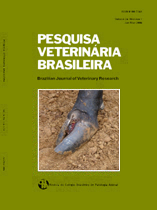 |
|
|
|
Year 2009 - Volume 29, Number 11
|

|
Poisoning by Stryphnodendron fissuratum (Mimosoideae) in cattle, 29(11):951-957
|
ABSTRACT.- Ferreira E.V., Boabaid F.M., Arruda L.P., Lemos R.A.A, Souza M.A., Nakazato L. & Colodel E.M. 2009. [Poisoning by Stryphnodendron fissuratum (Mimosoideae) in cattle.] Intoxicação por Stryphnodendron fissuratum (Mimosoideae) em bovinos. Pesquisa Veterinária Brasileira 29(11)951-957. Departamento de Clínica Médica Veterinária, Faculdade de Agronomia e Medicina Veterinária, Universidade Federal de Mato Grosso, Cuiabá, MT 78068-900, Brazil. E-mail: moleta@ufmt.br
Epidemiological, clinical and pathological aspects of natural and experimental Stryphnodendron fissuratum poisoning in cattle in Central-Western Brazil were evaluated. The coiled pods of this tree are popularly known as “rosquinha” (small coil); they mature during July-September, when they fall to the ground, and are consumed by cattle causing mortalities. Spontaneous outbreaks of poisoning were investigated in the municipalities of Aruanã, State of Goias, Guiratinga and Rondonópolis State of Mato Grosso, and Rio Verde de Mato Grosso, State of Mato Grosso do Sul. Commonly the poisoning occurred in properties with Nelore cattle herds, which were raised extensively on Brachiaria spp. pastures. The clinical course in natural cases ranged from 24 hours to 10 days, and the morbidity and case fatality rates were 0.9-25% and 15-100%, respectively. The main clinical signs in the spontaneous poisoning were apathy, anorexia, agressiveness, jaundice, sialorrhoea, incoordination, dysmetria, retraction of the abdomen, uneasiness and pasty black feces with stings of mucus or blood, diarrhea, edema of the dewlap and photosensitization. At necropsy, jaundice, edema of the subcutaneous tissue, mainly of the cervical region, hemorrhages of serous membranes, ascitis and hidrotorax, edema of the mesentery, perirenal edema, increased size of liver and kidney, reddening of the ruminal mucosa, and abomasum ulcers were observed. The diagnosis of S. fissuratum poisoning was based on epidemiological, clinical and pathological findings, and in the experimental reproduction by the administration of the pods of this plant to cattle. Experimentally, daily doses of 4 and 20g of pods by kg body weight, respectively, were administered to two bovines. Both animals had digestive signs and died, but photosensitization was not observed. |
| |
|
|
| |
|
 |